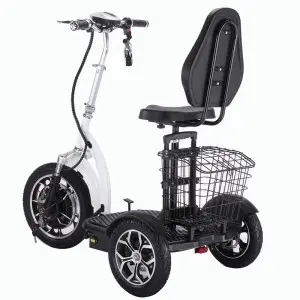The Unique Demand for Three-Wheeled Scooters for Seniors in the Asian Market
With Japan’s population aged 65 and above exceeding 29%, China’s population aged 60 and above exceeding 300 million, and Singapore boasting one in every five senior citizens, the right of seniors to independent mobility has become a core concern in Asian societies. As a key vehicle connecting families and communities, the demand for three-wheeled scooters transcends the basic nature of a “mobility tool” and is deeply influenced by regional geography, family culture, and the policy environment. Unlike the European and American markets, which prioritize speed and range, Asian users’ needs focus more on navigability in narrow streets and alleys, practicality for multi-generational living, adaptability to strict regulations, and a reliance on intelligent safety—all these characteristics collectively shape the unique landscape of the Asian market.
I. Geographical DNA: Adaptability from Congested Streets to Complex Road Conditions
The spatial layout of Asian cities directly determines the physical requirements of scooters. Japan’s dense population and limited land, China’s intertwined urban and rural areas, and Singapore’s high-density communities have fueled a demand for extreme vehicle size.
The Japanese market’s demands are highly representative. Its regulations stipulate that light mobility vehicles must be less than 3.4 meters in length, 1.48 meters in width, and 2.0 meters in height. These dimensions, derived from the K-Car, are essentially designed to accommodate the narrow roads and tight parking spaces in cities like Tokyo and Osaka. Data shows that micro mobility vehicles meeting these standards account for over one-third of sales in Japan, confirming the market logic that “small size is essential.” Toyota’s two-seater electric mobility scooter, the C+pod, was withdrawn from the market due to product shortcomings, but its 1.3-meter width precisely addressed the core needs of navigating Japanese streets and alleyways. In China, demand exhibits a “dual urban-rural divide”: Urban communities need to accommodate the flow of people and elevators within their communities, requiring vehicles to be under 1 meter wide (for example, the Aima Levi CA510 Ultimate Edition has a width of 0.94 meters, making it suitable for community use). Rural areas, on the other hand, need to accommodate the bumpy terrain of rural roads, driving the need for high ground clearance and wear-resistant tires. Singapore goes even further, defining three-wheeled mobility scooters as “personal mobility aids (PMAs)” and explicitly requiring a “single seat and compact body.” Violations carry fines of up to 10,000 Singapore dollars. These stringent regulations are forcing products to evolve towards extreme miniaturization.
II. Family Ethics: The Need for Complex Functionality in Multi-Generational Living
The cultural tradition of “family first” has enabled Asian mobility scooters to transcend the single-person tool and become mobile spaces that carry family responsibilities. This demand is particularly prominent in the Chinese and Japanese markets. China’s “two-child” model has spurred demand for vehicles with multiple functions, including transportation and pick-up. The Aima Levi CA510 Ultimate Edition, with its 370mm + 740mm front and rear seat space, is designed to meet the travel needs of elderly individuals with two children. The rear seat can accommodate two children, and the storage space can accommodate school bags and shopping bags, making it perfectly suited for daily routines like picking up children from school and going to the market. This demand for a “one vehicle for multiple uses” is essentially a reflection of the Asian family model of “intergenerational mutual assistance” applied to transportation.
Japan places a greater emphasis on “care convenience.” For elderly people living alone and those recovering from illness, mobility scooters often require integrated “family linkage” functionality. Wandechang’s Smart Mobility Robot 3.0 allows family members to view the elderly’s location and health data via an app. This design addresses the pain point of remote care in Japan amidst a declining birthrate. In Tokyo’s rehabilitation centers, mobility scooters with armrests and adjustable seats account for over 60% of all vehicles. Their core value lies in helping stroke patients achieve the dual goals of “independent mobility + rehabilitation training.”
III, Policy Red Lines: Compliance Requirements within the Regulatory Framework
Asian countries differ significantly in their definition of mobility scooters. Compliance has become the primary barrier to market entry, directly influencing product design.
China’s policy evolution is highly representative. From the early days of unlicensed and unregistered “Laotoule” vehicles to their inclusion in the “micro-low-speed pure electric passenger vehicle” regulatory scope by the Ministry of Industry and Information Technology in 2021, policies have forced products to transition towards standardization and compliance. Current mainstream products, such as the three-wheeled derivative of the Hongguang MINIEV, are equipped with vehicle identification numbers (VINs) and crash safety structures, essentially to meet the compliance threshold for licensed vehicles and road use.
Japan’s regulatory system is more mature. Beyond size restrictions, the policy benefit of “registering without a garage” has directly promoted the widespread adoption of mobility scooters in households. Singapore’s regulations are extremely stringent: not only do mobility scooters require speed limits (typically ≤15 km/h) but they also clearly define usage zones (e.g., prohibiting access to main roads). This comprehensive control approach requires products for the Singaporean market to be pre-installed with “regional positioning + speed lock” features; otherwise, they will fail compliance inspections.
IV. Safety Anxiety: The Need for Smart Protection amidst an Aging Population
With the increasing number of elderly people living alone, “safety protection” has become a core concern for Asian users. Smart technology is rapidly penetrating the mobility scooter market, with demand far exceeding the basic safety standards of European and American markets.
Obstacle avoidance and warning functions have become essential. The lidar system in Wandechang’s Smart Mobility Robot 3.0 can identify obstacles with 0.1 mm accuracy, anticipating risks such as steps and pedestrians and automatically braking. This design precisely addresses the pain point of elderly people’s slow reaction times. In Japan, similar products also incorporate a “one-touch return” feature—when elderly people get lost, they can automatically return to their starting point with the push of a button. Data from a Tokyo manufacturer shows that this feature has reduced the rate of elderly users seeking help for lost items by 78%.
The integration of health monitoring is particularly distinctive in Asia. To address common chronic conditions like hypertension and diabetes, some high-end mobility scooters are equipped with contactless vital sign monitoring modules. Abnormal blood pressure and heart rate signals are immediately sent to family members and community hospitals. This integrated “mobility tool + health sentinel” design is highly attractive in Asian cities where medical resources are limited. A pilot program at a Shenzhen health and wellness community showed that mobility scooters equipped with this feature reduced the rate of delayed medical treatment for elderly people suffering from sudden illnesses by 40%.
V. Price Sensitivity: The Art of Balancing Cost and Value
Despite diverse demand, the Asian market is far more price-sensitive than its European and American counterparts. “High cost-performance” remains the key to mass adoption. The Chinese market’s price acceptance is clear: basic three-wheeled mobility scooters range from 2,000 to 6,000 yuan. The Aima Levi CA510 Ultimate Edition, with its 72V large-capacity battery, sells for 6,599 yuan, setting a benchmark for “high-end value.” In contrast, the mainstream price in the Japanese market is around 48,000 yuan (1 million yen). This difference stems from Japanese users’ willingness to pay a premium for brand and compliance.
Notably, “cost control” is becoming a breakthrough in the industry. Companies like Wandechang have reduced the price of smart mobility scooters from tens of thousands of yuan to around 15,000 yuan by optimizing perception modules (reducing lidar costs) and scaling production (compressing mechanical structure costs). This strategy of “downgrading technology without sacrificing features” is driving product penetration from institutional purchases to household consumption.
Conclusion: Product innovation must be anchored in “Asian DNA”
The uniqueness of the Asian elderly three-wheeled mobility scooter market is fundamentally the result of the combined effects of “geographic constraints, family culture, and policy regulation.” Brands seeking a foothold in this emerging market must abandon the simplistic mindset of “Asianizing European and American products.” In Japan, they must adhere to the bottom line of “small size and regulatory compliance.” In China, they must balance “urban and rural applications” with “family functionality.” In Singapore, they must meet regulatory requirements for “extreme compactness and secure locking.” Only by incorporating these regional characteristics into product design can they truly achieve the value proposition of “mobility as a lifestyle companion”—a core requirement of the Asian market.
Post time: Sep-24-2025



